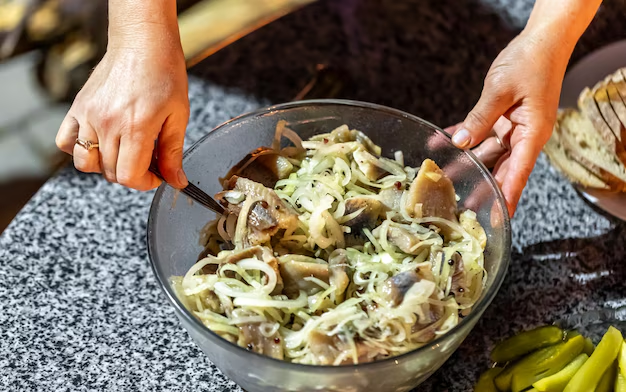How to Craft Delicious Refrigerator Dill Pickles at Home
If you've ever craved the tangy, crisp delight of a dill pickle, you’re not alone. Making refrigerator dill pickles at home is an art that marries simplicity with satisfaction. This guide dives deep into the process, offering insights and tips that will turn your kitchen into a small pickle factory. Ready to conquer the culinary world of pickles? Let’s get started!
🥒 Discovering the World of Dill Pickles
Dill pickles, particularly refrigerator varieties, have stood the test of time, beloved by food enthusiasts across the globe. Unlike their fermented counterparts, refrigerator dill pickles offer a quicker turnaround and a fresher taste, making them perfect for those impromptu cravings.
What Sets Refrigerator Pickles Apart?
Refrigerator dill pickles are not fermented, which means they don't develop the same fizz and complexity as fermented pickles. Instead, they are steeped in a vinegar brine that lends a tangy flavor and maintains the crunch of the cucumbers. The primary advantage? They're ready in a fraction of the time and are ideal for those who prefer a crisp texture.
Essential Ingredients and Tools
Before you embark on this flavorful journey, gather your supplies. Here’s what you’ll need:
🌿 Key Ingredients:
- Cucumbers (preferably pickling cucumbers): The star of the show, their size and texture significantly impact the result.
- Fresh Dill: Both fronds and seeds add depth and aroma.
- Garlic: Adds a pungent kick. Feel free to adjust the quantity based on your preference.
- Vinegar: White vinegar is commonly used, but apple cider vinegar can add a unique twist.
- Water: To dilute the vinegar and control the acidity.
- Salt: Go for non-iodized varieties like sea or kosher salt.
- Sugar (optional): Helps balance flavors, though some prefer their pickles without it.
🛠️ Tools of the Trade:
- Jars: Mason jars are standard, offering a perfect seal and ample space.
- Saucepan: For heating your brine.
- Measuring Cups and Spoons: Precision is key.
- A Sharp Knife: For slicing cucumbers to uniform thickness.
Step-by-Step Approach to Pickling
Achieving the perfect refrigerator dill pickle involves a clear, methodical approach. Here's how:
1. Preparation is Key
Choose Your Cucumbers Wisely: Select firm, blemish-free cucumbers. Size is crucial; smaller cucumbers, around 4 inches long, work best.
Wash and Trim: Rinse cucumbers thoroughly. Trim off the blossom ends as they contain enzymes that can soften your pickles.
2. Making the Brine
Combine Ingredients: In a saucepan, mix vinegar, water, salt, and sugar (if using). Heat over medium, stirring until salt and sugar dissolve completely.
Cool It Down: Once mixed, remove from heat and let the brine cool to room temperature. Cooling prevents the cucumbers from cooking and losing crispness.
3. Packing the Jars
Layer Flavors: In your jar, place dill, garlic, and any additional spices or aromatics you desire (like peppercorns or mustard seeds).
Add Cucumbers: Pack the cucumbers snugly in the jar. Overpacking can lead to uneven pickling, while underpacking wastes space.
Pour the Brine: Once cooled, pour the brine over the cucumbers, ensuring they are fully submerged.
4. Refrigerate and Wait
Seal and Chill: Secure your jars with lids and place them in the refrigerator. Now comes the hardest part—waiting.
Time is of the Essence: For the full spectrum of flavors, allow at least 48 hours before diving in. They will intensify over time, with optimal flavor achieved in about a week.
Exploring Pickle Variations
Want to take your pickles to the next level? Here are some creative spins:
🌶️ Spice It Up
For those who crave a little kick with their crunch, adding a sliced jalapeno or a pinch of red pepper flakes can transform your pickles into a spicy snack.
🥒 Sweet and Sour
Introduce sugar into the brine for a sweet twist. This will take your pickles closer to the bread-and-butter variety, offering a sweet and tangy combo.
🌶️ Herbal Infusions
Explore beyond dill with herbs like thyme or rosemary for a unique aromatic profile.
Storage and Longevity
Refrigerator pickles can last up to two months when stored properly. Here’s how to ensure they remain fresh and flavorful:
- Keep Them Cold: As the name suggests, these pickles are best kept in the fridge. They are not shelf-stable and require refrigeration to maintain their texture and safety.
- Monitor Seals: Ensure the jar lids are tight but not overtightened. This helps maintain freshness and prevents spillage.
A Simple Summary for Quick Reference
Here's a handy checklist to keep you on track during your pickling adventure:
- 🥒 Choose Firm Cucumbers: Trim and prepare for the best crunch.
- 🌿 Prepare Your Brine: Mix vinegar, water, salt, and optional sugar.
- 🛠️ Pack Your Jars: With cucumbers, dill, garlic, and spices.
- 🔒 Refrigerate Immediately: Allow 48 hours for flavors to meld.
Troubleshooting Common Pickling Problems
Even the best-laid plans can encounter hiccups. Here’s how to address some typical pitfalls:
Mushy Pickles: Check your cucumber choice and trimming technique. Ensure the brine is cooled before pouring.
Floating Cucumbers: Ensure jars are filled properly. Adding a small, clean rock on top of cucumbers can help them stay submerged.
Too Salty/Vinegary: Adjust subsequent batches by experimenting with your brine ratios. Small tweaks can substantially alter the final taste.
Bringing It All Together with Confidence
Crafting your batch of refrigerator dill pickles is more than a recipe; it's an experience that engages the senses and rewards patience. Whether you're a pickle purist or someone seeking culinary experimentation, this guide equips you with the know-how to succeed.
Mastering the art of pickles not only fills your pantry but also brings a sense of pride and accomplishment. So next time you're in the kitchen, remember: a jar of homemade dill pickles is just a few easy steps away from perfection. Dive in, experiment, and relish each crunchy, tangy bite!
